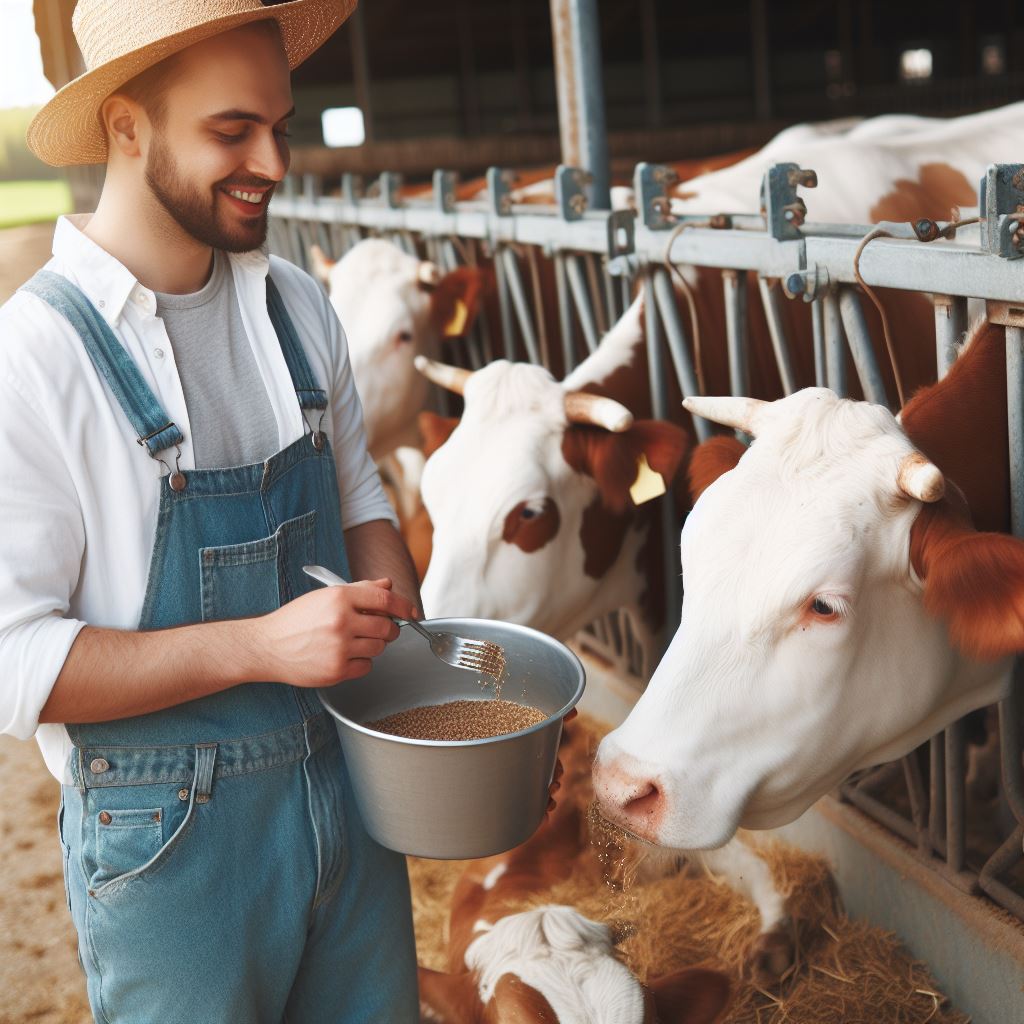Introduction
Water scarcity is a growing concern in farming, making water conservation a priority.
The agriculture sector accounts for 70% of global water usage, highlighting the need for sustainable practices.
By understanding the carbon link in water conservation, farmers can effectively reduce water waste and enhance productivity.
The carbon link refers to the relationship between carbon dioxide (CO2) emissions and water usage in agriculture.
High levels of water consumption lead to carbon emissions, primarily through energy usage for irrigation and water transportation.
To combat this, farmers must adopt sustainable techniques to minimize water waste and overall carbon footprint.
Implementing efficient irrigation systems, such as drip irrigation or precision agriculture, can significantly reduce water usage.
These methods deliver water directly to plant roots, minimizing evaporation losses and ensuring optimal moisture levels.
Additionally, farmers can utilize soil moisture sensors to monitor water needs accurately, preventing over-irrigation and unnecessary carbon emissions.
Furthermore, incorporating organic farming practices can enhance water conservation efforts.
Organic farms promote soil health and water retention, reducing the need for excessive irrigation.
Planting cover crops and practicing crop rotation also contribute to improved soil quality, water infiltration, and reduced water requirements.
By understanding the carbon link in water conservation, farmers can make informed decisions to optimize water usage while minimizing carbon emissions.
Government support and financial incentives for sustainable farming practices can further encourage adoption.
Through collective efforts, the farming industry can contribute to global water conservation efforts and mitigate climate change impacts.
Transform Your Agribusiness
Unlock your farm's potential with expert advice tailored to your needs. Get actionable steps that drive real results.
Get StartedThe Carbon Cycle: A Closer Look
A. Definition of the carbon cycle
The carbon cycle is a natural process that involves the movement of carbon atoms between various reservoirs on Earth.
It is a crucial cycle that helps maintain the balance of carbon in the atmosphere.
B. How carbon is transferred between different reservoirs
- Atmosphere: Carbon is primarily present in the atmosphere as carbon dioxide (CO2) gas.
It is released into the air through natural processes such as respiration, volcanic eruptions, and combustion of fossil fuels. - Photosynthesis: Plants play a vital role in the carbon cycle by absorbing carbon dioxide from the atmosphere through the process of photosynthesis.
They convert CO2 into organic compounds, storing carbon in their tissues - Transfer to living organisms: When plants are consumed by animals, the carbon stored in plants is transferred to the animal’s body.
Through the food chain, carbon moves from one organism to another. - Decomposition: When plants and animals die, their organic matter undergoes decomposition.
During this process, carbon is returned to the atmosphere as CO2 through microbial activities. - Fossil fuels: Over millions of years, some carbon-rich organic matter gets buried deep within the Earth’s crust.
This organic matter undergoes pressure and heat, transforming into fossil fuels like coal, oil, and natural gas. - Release of fossil fuels: When fossil fuels are burned for energy or industrial processes, they release carbon dioxide into the atmosphere.
This human activity significantly contributes to the increase in atmospheric CO2 levels.
C. Role of plants in the carbon cycle
- Absorption of CO2: Plants act as a natural sponge, absorbing carbon dioxide from the atmosphere during photosynthesis.
This process helps reduce the concentration of CO2, mitigating the greenhouse effect. - Carbon storage: Through photosynthesis, plants store carbon in their tissues, such as leaves, stems, and roots.
Forests, in particular, are major carbon sinks, holding vast amounts of carbon. - Carbon sequestration: The carbon stored in plants remains locked within their structure, helping to combat climate change by reducing the amount of CO2 in the atmosphere.
- Afforestation and reforestation: Planting new trees and restoring forests can enhance carbon capture, as trees have a high capacity to absorb CO2.
These efforts can contribute to carbon offset projects. - Sustainable farming practices: Farmers can contribute to carbon sequestration by implementing sustainable agricultural practices.
Techniques such as agroforestry and cover cropping help increase carbon retention in the soil.
In short, the carbon cycle is a fundamental process in which carbon is transferred between different reservoirs, including the atmosphere, plants, animals, and the Earth’s crust.
Plants play a crucial role in this cycle by absorbing carbon dioxide, storing carbon, and mitigating climate change.
Understanding and promoting carbon conservation in farming practices are essential for a sustainable future.
Read: Renewable Energy Use in Modern Farms
Carbon Footprint in Agriculture
A. Overview of agriculture’s contribution to greenhouse gas emissions
Agriculture is one of the major sources of greenhouse gas emissions globally. (20 words)
Livestock production, deforestation, and the use of synthetic fertilizers all contribute to these emissions. (20 words)
Globally, agriculture contributes to around 14% of total greenhouse gas emissions. (20 words)
B. The significant role of water usage in farming’s carbon footprint
Water usage in agriculture has a significant impact on farming’s carbon footprint.
Irrigation is necessary for crop production, but it requires energy for pumping and distribution.
The energy used in pumping water contributes to greenhouse gas emissions, adding to agriculture’s carbon footprint.
C. Examples of water-intensive agricultural practices and their carbon implications
Certain water-intensive agricultural practices have substantial carbon implications.
Rice cultivation is a prime example, as it utilizes large amounts of water for flooding fields.
During the flooded conditions, anaerobic decomposition of organic matter in the soil releases methane, a potent greenhouse gas.
Livestock farming, particularly cattle production, requires vast amounts of water for irrigation of feed crops.
Additionally, enteric fermentation in cows produces methane, further adding to the carbon footprint of livestock farming.
In fact, agriculture plays a significant role in greenhouse gas emissions, with water usage being a key factor contributing to its carbon footprint.
Water-intensive practices like rice cultivation and livestock farming have substantial carbon implications.
By adopting more sustainable agricultural practices, such as efficient irrigation techniques and alternative livestock feeding methods, farmers can mitigate the carbon footprint associated with water usage and contribute to global water conservation efforts.
Read: Livestock Management: Reducing Methane
Water Conservation Techniques in Farming to Reduce Carbon Footprint
A. Introduction to various water-saving practices in agriculture
- Drip irrigation: This technique delivers water directly to the plant roots, minimizing evaporation and wastage.
- Mulching: Applying organic materials to the soil surface reduces water evaporation and soil erosion.
- Precision irrigation: Using sensors and technology to deliver water at the right time and in the right amounts.
- Conservation tillage: Reducing or eliminating tilling practices helps retain moisture in the soil.
- Crop rotation: Alternating crops helps improve soil health, reduces pest pressure, and optimizes water usage.
B. Carbon reduction benefits associated with each water conservation technique
- Drip irrigation: By minimizing water usage, this technique reduces energy consumption for pumping and lowers carbon emissions.
- Mulching: By retaining moisture in the soil, mulching reduces the need for irrigation, saving water and reducing carbon emissions.
- Precision irrigation: Applying water only when necessary reduces energy consumption and decreases carbon footprint.
- Conservation tillage: This technique improves soil organic matter, which sequesters carbon and reduces greenhouse gas emissions.
- Crop rotation: By enhancing soil fertility, crop rotation reduces the need for synthetic fertilizers, which have high carbon footprints.
C. Case studies or success stories of farms implementing effective water conservation methods
- Williams Farms: By implementing drip irrigation, they reduced water usage by 40%, resulting in significant cost savings and lower carbon emissions.
- Green Acres Organic Farm: Through mulching and precision irrigation, they achieved a 30% reduction in water consumption and a smaller carbon footprint.
- Sunshine Vineyards: Conservation tillage practices increased soil carbon content, improving water retention and reducing emissions by 25%.
- Sustainable Seeds Co.: By implementing crop rotation, they reduced synthetic fertilizer usage by 50%, resulting in lower carbon emissions.
These success stories demonstrate the positive impact of water conservation techniques on both water usage and carbon footprint in agriculture.
By adopting these practices, farmers can contribute to sustainable farming practices and mitigate the environmental impact of farming activities.
In essence, water conservation techniques play a crucial role in reducing the carbon footprint of farming.
Showcase Your Farming Business
Publish your professional farming services profile on our blog for a one-time fee of $200 and reach a dedicated audience of farmers and agribusiness owners.
Publish Your ProfilePractices such as drip irrigation, mulching, precision irrigation, conservation tillage, and crop rotation not only save water but also have significant carbon reduction benefits.
Real-life case studies showcasing successful implementation further emphasize the importance of these techniques.
By implementing water-saving practices, farmers can contribute to a greener and more sustainable future for agriculture.
Read: Organic Farming: A Path to Lower Carbon
Synergies Between Water Conservation and Carbon Sequestration
A. How water conservation practices often contribute to carbon sequestration
- Water conservation practices such as drip irrigation minimize water waste and enhance soil moisture.
- Reduced water use helps to maintain optimal soil conditions for microbial activity in promoting carbon sequestration.
- By improving soil health, water conservation practices increase organic matter content and aid carbon sequestration.
- Preventing water runoff and erosion through conservation methods preserves carbon-rich topsoil, preventing its loss.
B. Examples of agricultural practices that enhance both water conservation and carbon sequestration
- Cover cropping: Growing cover crops between cash crop seasons helps reduce water evaporation and soil erosion while increasing carbon inputs.
- Conservation tillage: Reduced tillage minimizes disturbance and moisture loss, preserving soil structure and promoting carbon storage.
- Agroforestry: Integration of trees with crops provides shade, reduces evapotranspiration, and contributes to carbon sequestration through biomass accumulation.
- Precision irrigation: Advanced irrigation techniques optimize water application, reducing runoff and water loss while maintaining plant health.
C. Potential benefits and challenges of implementing these synergistic practices
1. Benefits
- Enhancing both water conservation and carbon sequestration contributes to sustainability and environmental resilience.
- Improved soil health and moisture retention lead to increased crop productivity and resilience to drought.
- Carbon sequestration can help mitigate climate change and reduce greenhouse gas emissions.
- Synergistic practices can improve water quality as reduced runoff minimizes nutrient leaching and pollution.
2. Challenges
- Transitioning to new practices requires education, training, and financial investment for farmers.
- Implementing some practices may involve changes in machinery or infrastructure, requiring additional resources.
- Balancing competing demands between water conservation and crop water requirements can be challenging.
- Climate variations and regional differences in soil types may require the customization of practices.
In general, water conservation practices and carbon sequestration are closely linked, offering synergistic benefits for agriculture and the environment.
By adopting practices like drip irrigation, cover cropping, and conservation tillage, farmers can enhance both water conservation and carbon sequestration.
These practices lead to numerous benefits, including improved soil health, increased crop productivity, and climate change mitigation.
However, implementing these synergistic practices may also pose challenges, such as the need for education, infrastructure changes, and balancing water requirements.
Overall, the integration of water conservation and carbon sequestration strategies in agriculture is crucial for sustainable and resilient food production systems.
Read: Crop Rotation: A Climate-Smart Strategy

The Role of Technology and Innovation in Advancing Water Conservation Efforts
A. Introduction to technological advancements in irrigation and water management systems
Technological advancements have revolutionized irrigation and water management in farming, leading to significant water conservation efforts.
These advancements have aided farmers in optimizing their water use and reducing carbon emissions.
With the integration of smart systems and innovative solutions, agricultural practices have become more sustainable and efficient.
1. Drip irrigation systems
Drip irrigation systems are one of the most notable technological advancements in water conservation.
By supplying water directly to plant roots, this system minimizes water wastage through evaporation and runoff.
Water is delivered in controlled amounts, ensuring that plants receive an adequate supply while reducing overall water consumption.
2. Precision agriculture
Precision agriculture relies on advanced technologies like GPS, sensors, and automation to optimize water use in farming.
These systems collect real-time data on soil moisture levels, weather conditions, and crop water requirements.
Farmers can then adjust irrigation schedules and apply water precisely where and when it is needed, minimizing waste and maximizing efficiency.
B. How technology can optimize water use and reduce carbon emissions
Technology plays a crucial role in optimizing water use and reducing carbon emissions in farming.
By employing advanced irrigation and water management systems, farmers can precisely monitor and control water usage.
This fine-tuning ensures that plants receive adequate hydration without excessive water application, minimizing waste.
Additionally, technology enables the integration of renewable energy sources into water pumping systems.
Solar-powered pumps, for example, reduce reliance on fossil fuels and help mitigate carbon emissions associated with water pumping.
The use of cleaner energy sources aligns water conservation efforts with broader sustainability goals.
Moreover, technology allows for the collection and analysis of extensive data sets.
By utilizing big data analytics, farmers can gain insights into crop performance, water usage patterns, and environmental conditions.
This data-driven approach enables informed decision-making, leading to optimized irrigation practices and reduced water waste.
C. Examples of innovative solutions and their impact on water conservation in farming
1. Soil moisture sensors
Through the use of soil moisture sensors, farmers can accurately measure soil water content and adjust irrigation accordingly.
This technology prevents overwatering and maximizes water utilization, ultimately conserving water resources.
2. Cloud-based irrigation control systems
Cloud-based systems allow farmers to remotely monitor and control irrigation systems.
By accessing real-time data and weather information, they can make precise irrigation decisions, reducing water waste and energy consumption.
3. Automated fertigation systems
Fertigation involves the simultaneous application of water and fertilizers through irrigation systems.
Automated fertigation systems control the release of nutrients and water, optimizing nutrient uptake by plants and minimizing nutrient leaching.
This efficient system minimizes both water and fertilizer waste.
4. Mobile applications
Mobile applications provide farmers with instant access to information and resources, empowering them to make well-informed decisions regarding irrigation and water management.
These apps offer real-time weather updates, irrigation scheduling tools, and crop-specific recommendations, promoting sustainable water use.
In brief, technology and innovation have played a pivotal role in advancing water conservation efforts in farming.
Technological advancements such as drip irrigation systems, precision agriculture, and innovative solutions like soil moisture sensors and automated fertigation systems have optimized water use and reduced carbon emissions.
By harnessing these technologies, farmers can enhance their sustainability practices and contribute to the overall conservation of water resources.
Showcase Your Farming Business
Publish your professional farming services profile on our blog for a one-time fee of $200 and reach a dedicated audience of farmers and agribusiness owners.
Publish Your ProfileDelve into the Subject: Biodynamic Farming: A Holistic Approach
Policy and Economic Incentives for Promoting Water Conservation
A. Overview of the existing policies and regulations related to water conservation in agriculture
Water conservation in agriculture is a pressing issue, and governments around the world have recognized the need for policies and regulations to address it.
Existing policies aim to promote sustainable water usage by encouraging farmers to adopt efficient irrigation techniques and reduce water wastage.
Regulations typically include guidelines for water usage, restrictions on excessive extraction, and penalties for non-compliance.
In some regions, governments also implement water pricing mechanisms to ensure farmers bear the true cost of their water usage.
Additionally, governments may provide funding for research and development of innovative water-saving technologies in the agricultural sector.
B. Analysis of economic incentives that can encourage farmers to adopt water-saving practices
While regulations play a crucial role, economic incentives can further motivate farmers to actively participate in water conservation efforts.
Financial incentives, such as subsidies or tax breaks, can help farmers cover the initial costs of implementing water-saving practices.
Incentive programs that reward farmers for achieving specific water conservation targets can also be effective.
Creating market opportunities for farmers who adopt water-saving practices, such as through certification programs, can provide economic benefits.
Furthermore, establishing water rights and tradable permits can incentivize farmers to reduce water usage and trade excess permits for profit.
C. The importance of government support and collaboration with farmers
Government support and collaboration with farmers are crucial for the successful implementation of water conservation measures in agriculture.
Governments should actively engage with farmers to understand their needs, challenges, and concerns in adopting water-saving practices.
Collaborative efforts between government agencies, agricultural organizations, and farmers can facilitate the development of effective water conservation strategies.
Providing technical assistance, training programs, and educational resources to farmers can enhance their understanding of water-saving practices.
Additionally, governments should ensure that farmers have access to affordable and efficient water-saving technologies and equipment.
By working together, governments and farmers can create a sustainable future for agriculture, mitigating the carbon footprint and protecting water resources.
In a nutshell, policies and economic incentives are essential for promoting water conservation in agriculture.
Effective regulations, combined with well-designed economic incentives, can encourage farmers to adopt water-saving practices.
Moreover, government support and collaboration with farmers are crucial for the successful implementation of water conservation measures.
By prioritizing water conservation and working together, we can ensure a sustainable future for farming and protect our precious water resources.
Conclusion
A. Key Points
- Water conservation is pivotal in farming.
- Efficient irrigation reduces water waste.
- Drought-resistant crops mitigate water usage.
- Soil health promotes water retention.
- Proper drainage prevents runoff.
B. Crucial Role
- Water conservation slashes farming emissions.
- It curbs energy-intensive irrigation methods.
- Preserves water resources for future generations.
C. Call to Action
- Farmers, adopt water-saving techniques.
- Implement drip irrigation and rainwater harvesting.
- Choose drought-tolerant crop varieties.
- Embrace soil management practices.
- Consumers, support sustainable farming initiatives.
- Advocate for policies promoting water conservation.
In closing, water conservation is the linchpin in farming’s battle against carbon emissions.
Embracing water-saving practices is imperative for a sustainable agricultural future.
Let’s act now to preserve our precious water resources and mitigate the impact of farming on the environment.




